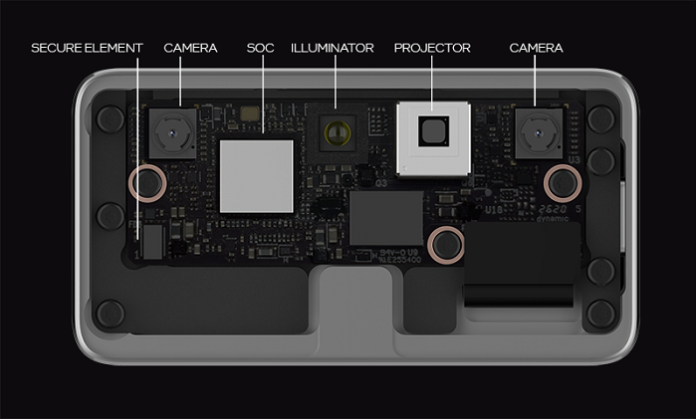Expanding its RealSense technology portfolio, Intel Corp. has unveiled RealSense ID, an on-device facial authentication solution that combines an active depth sensor with a specialized neural network for high-accuracy and secure facial authentication. Available in either a module or peripheral device, the RealSense ID 450/455 can be used in a variety of applications ranging from smart locks and access control to retail point of sale, ATMs, and kiosks.
For a high-level security, the RealSense ID module builds in anti-spoofing technology to protect against false entry attempts using photographs, videos, or masks, and provides a one-in-one-million false acceptance rate. The true acceptance rate is 99.7% and spoof acceptance rate is <1%, according to the datasheet.
In addition to the active depth sensor and specialized neural network, the RealSense ID 450 module, measuring 50 x 18 x 4.6 mm, incorporates all of the optical components and processing hardware to integrate local face authentication capabilities into new and existing products. Integrated components include a system on chip (SoC), embedded secure element for encryption, two cameras, an illuminator (IR LED), and an IR dot projector. The RealSense ID 455 peripheral device, which incorporates the module, is slightly larger, measuring 62 x 32.5 x 11 mm.

Intel RealSense ID solution F450 module components (Image: Intel Corp.)
“With this size and simplicity provided with an open-source SDK we make it very easy for every use case to enable facial authentication,” said Sagi Ben Moshe, Intel corporate vice president and general manager of Emerging Growth and Incubation. “From a developer point of view, with a few lines of code you can be up and running.”
How it works
Intel makes the enrollment process easy – no network setup is required and authentication takes less than one second (<0.8 s). The embedded F450 module works by using a closed system with neural network algorithms running a real time operating system (RTOS). The face authentication uses image pre-processing, anti-spoofing checking, and the SoC matrix acceleration engine to extract the face features of the user, said Intel.

(Image: Intel Corp.)
For privacy and user protection, the solution processes all facial images locally and encrypts all user data. The solution is only activated through user awareness and will not authenticate unless prompted by a pre-registered user.
The RealSense ID Solution F450 optical system and the face authentication algorithms are optimized for functional and performance profiles targeted at access control devices.

F450/F455 Functional metrics (Source: Intel datasheet)
Intel RealSense ID facial authentication adapts to the physical changes of users, operates in various lighting conditions and different angles, and works for people with a range to complexions, thanks to Intel’s proprietary algorithms.
The solution has an active depth sensor with this specialized neural network for accurate and user-aware facial authentication, said Joel Hagberg, head of product marketing and product management for Intel RealSense. It does adapt over time as you age, which means if you change your appearance – grow facial hair, lose your hair, change your hairstyle, or add glasses or sunglasses or wear a hat or headset it will adapt to ensure authentication, he added.
In addition, the anti-spoofing technology protects against false attempts using photographs videos, selfies, or even very expensive Hollywood-type masks, Hagberg continued. “We have one-in-one-million false acceptance rate, which is top tier with NIST benchmarks so that is another strength of our device.
“It’s only activated through user awareness and your intention to authenticate so it doesn’t authenticate unless prompted by a user approaching the device,” said Hagberg. “It is purpose built with on-device facial authentication and we contain the data within the device so you don’t expose your information outside of our product.”
It also will authenticate users who are wearing masks. However, the solution still needs to see your eyes and nose to get close to the one-in-one-million facial authentication, said Moshe. “If you see the nose, you’re very close to the original number.” Intel did not provide the false acceptance rate for authenticating mask wearers.
It also works with a variety of complexions, which has been a concern for many facial authentication devices, said Hagberg. “We’ve solved that with our algorithms.”
“We’ve done extensive data collection of all ethnicities, from Asia, Europe, Middle East, and Africa. With this purpose-built device we were very careful to ensure that we have all ethnicities covered. It is our proprietary algorithm and data set that we’re using for this authentication,” said Hagberg.
Intel invested a lot of money to build this proprietary database and massive data capturing project, said Moshe. “It took a lot of time to build and capture all this but this is what makes it unique.”

(Image: Intel Corp.)
Intel also provides a cloud server version of the software for distributed applications like bank ATMs or point-of-sale. Intel expects to start shipping the module and peripheral device by the end of the first quarter. List prices for module and peripheral device are $79 and $99, respectively. Already sampling to developers, Intel expects design wins to be announced shortly. The open-source SDK is available on GitHub. Intel will demo the technology at CES 2021.
“It’s very affordable,” said Hagberg. From an OEM integration point of view, it’s a very cost-effective solution to deliver facial authentication with a very secure and accurate solution, he added.
Advertisement
Learn more about Intel Corp.





